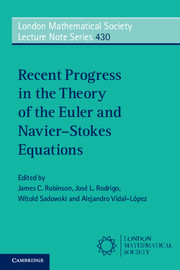Book contents
- Frontmatter
- Dedication
- Contents
- Preface
- List of contributors
- 1 Classical solutions to the two-dimensional Euler equations and elliptic boundary value problems, an overview
- 2 Analyticity radii and the Navier–Stokes equations: recent results and applications
- 3 On the motion of a pendulum with a cavity entirely filled with a viscous liquid
- 4 Modal dependency and nonlinear depletion in the three–dimensional Navier–Stokes equations
- 5 Boussinesq equations with zero viscosity or zero diffusivity: a review
- 6 Global regularity versus finite-time singularities: some paradigms on the effect of boundary conditions and certain perturbations
- 7 Parabolic Morrey spaces and mild solutions of the Navier–Stokes equations. An interesting answer through a silly method to a stupid question
- 8 Well-posedness for the diffusive 3D Burgers equations with initial data in H½
- 9 On the Fursikov approach to the moment problem for the three-dimensional Navier–Stokes equations
- 10 Some probabilistic topics in the Navier–Stokes equations
4 - Modal dependency and nonlinear depletion in the three–dimensional Navier–Stokes equations
Published online by Cambridge University Press: 05 January 2016
- Frontmatter
- Dedication
- Contents
- Preface
- List of contributors
- 1 Classical solutions to the two-dimensional Euler equations and elliptic boundary value problems, an overview
- 2 Analyticity radii and the Navier–Stokes equations: recent results and applications
- 3 On the motion of a pendulum with a cavity entirely filled with a viscous liquid
- 4 Modal dependency and nonlinear depletion in the three–dimensional Navier–Stokes equations
- 5 Boussinesq equations with zero viscosity or zero diffusivity: a review
- 6 Global regularity versus finite-time singularities: some paradigms on the effect of boundary conditions and certain perturbations
- 7 Parabolic Morrey spaces and mild solutions of the Navier–Stokes equations. An interesting answer through a silly method to a stupid question
- 8 Well-posedness for the diffusive 3D Burgers equations with initial data in H½
- 9 On the Fursikov approach to the moment problem for the three-dimensional Navier–Stokes equations
- 10 Some probabilistic topics in the Navier–Stokes equations
Summary
Abstract
A summary is given of recent work on numerical and analytical studies in nonlinear depletion in the 3D Navier–Stokes equations by Donzis et al. (2013) and Gibbon et al. (2014). These results are specifically discussed in terms of modal dependency, where the high modes are controlled by the lowest modes. The modes (frequencies) used are L2m-norms of vorticity.
Introduction
In fluid dynamics the idea that the low modes of a system might conceivably control the high modes has long been attractive, not least because it suggests a potential mechanism for the reduction in size and cost of computing high dimensional systems, in particular three dimensional turbulent flows. The idea has emerged in different guises over the last 40 years including the development of centre manifolds for ODEs (Guckenheimer & Holmes, 1997) and inertial manifolds for PDEs (Foias, Sell, & Temam, 1988, Titi, 1990, Foias & Titi, 1991, Robinson, 1996), together with the concept of determining modes and nodes (Foias & Temam, 1984). Success has been limited to the construction of an inertial manifold for the one-dimensional Kuramoto–Sivashinsky equation (Foias, Jolly, Kevrekidis, Sell, & Titi, 1988) and the achievement of an estimate for the number of determining modes and nodes for the 2D Navier–Stokes equations (Foias & Titi, 1991, Jones & Titi, 1993, Olson & Titi, 2003, 2008, Farhat, Jolly, & Titi, 2015). The 3D Navier–Stokes equations, however, have remained stubbornly resistant, the main obstacle being the issue of existence and uniqueness of solutions (Constantin & Foias, 1988, Doering & Gibbon, 1995, Foias, Manley, Rosa, & Temam, 2001, Escauriaza, Seregin, & Šverák, 2003).
Another major feature of work on the 3D Navier–Stokes equations has been the difficulty in interpreting the results of large scale numerical simulations in the context of the highly limited analytical results that are available : for early numerical results see Orszag & Patterson (1972), Rogallo (1981), Kerr (1985), Eswaran & Pope (1988), Jimenez, Wray, Saffman, & Rogallo (1993), Moin & Mahesh (1998). However, now that higher resolution is available, it is perhaps time to renew the idea of interpreting some more recent simulations to see if they can inform the analysis by suggesting new ways of considering the Navier–Stokes regularity problem: for more recent numerical work see Kurien & Taylor (2005), Ishihara, Gotoh, & Kaneda (2009), Donzis, Yeung, & Sreenivasan (2008), …
- Type
- Chapter
- Information
- Publisher: Cambridge University PressPrint publication year: 2016



